In-Between Worlds – Interview with Meryl McMaster (M.M) by Emese Krunák-Hajagos (E.K-H)
All I could see were the claws of a big brown and white animal hugging a tree trunk — that was the first image I saw from Meryl McMaster in a CONTACT group show a few years ago. It was completely behind the tree. Was it hiding from some predator? Or was it a predator itself, flying up ready to attack us in the next moment? What kind of species was it? Hard to decide. I was fearsome and playful at the same time. It touched something in the unconscious mind, somehow deeply connected to the animal world, maybe an ancient totem. Perhaps it was an animal hiding in a human body or maybe a human in an animal skin – a very strange photograph. I soon forgot the artist’s name but not the image.
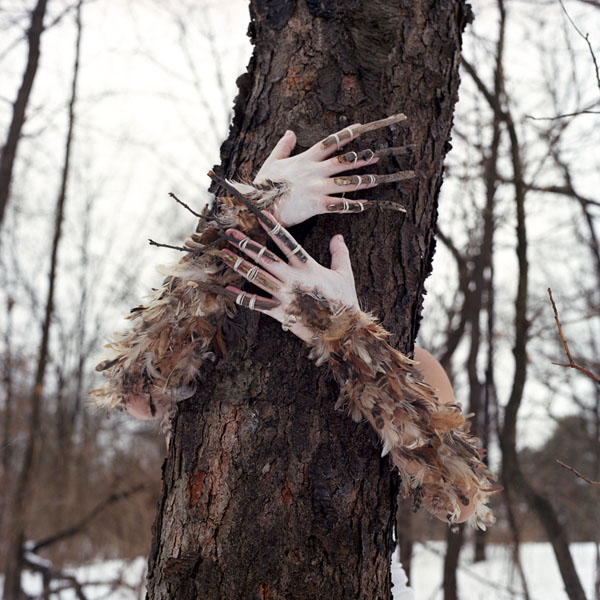 Meryl McMaster, Sentience, 2010. From In-Between Worlds series. Digital Chromogenic Print, 24″ x 24″. Courtesy of the artist
Meryl McMaster, Sentience, 2010. From In-Between Worlds series. Digital Chromogenic Print, 24″ x 24″. Courtesy of the artist
Wandering and slightly bored on a Saturday afternoon, at Katzman-Kamen Gallery, I saw a large photograph depicting a young woman. Her skin was painted white, like a Japanese mask, and she held a strange metal image in front of her face. It was an unsettling portrait with elements that don’t belong together. It reminded me of a masquerade, but I had a feeling that there was more to it. The artist’s name wasn’t there. Then 2012 NY Arts magazine included a similar image in its list of young artists to be watched. Meryl McMaster was young, talented and seemed to have unique imagery at her disposal. In 2013, in Toronto’s CONTACT, McMaster had a solo show with a new series – and looking at them I recognized that she has fulfilled that earlier promise.
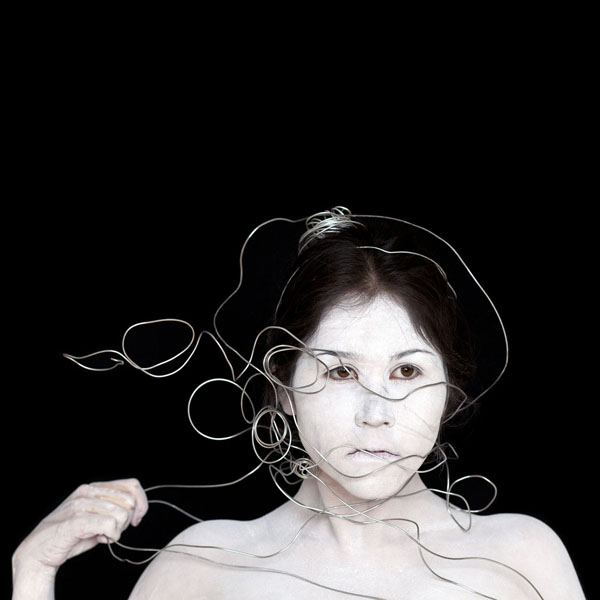 Meryl McMaster, Meryl 2, 2010. From the Second Self series. Digital Chromogenic Print, 36″ x 36″. Courtesy of the artist
Meryl McMaster, Meryl 2, 2010. From the Second Self series. Digital Chromogenic Print, 36″ x 36″. Courtesy of the artist
E.K-H: The show catalogue describes In-Between Worlds, the title of your last series as being about your mixed background. What are those worlds? How do you express them in your work?
M.M: My curiosity began with learning about where I came from. I grew up with many stories. My father’s family is Plains Cree from Saskatchewan and my mother’s family, also from Saskatchewan, are of British, Scottish and Dutch heritage. From an early age I was aware of the differences between my Aboriginal and European ancestors. This always caused conflict for me and posed a challenge in how I would identify with these opposing cultures. When I started thinking about this body of work, I wanted to transform the way I viewed the past from the perspective of the present and express my bi-cultural heritage as a synergistic strength as opposed to a struggle between opposites. In every image there are references and symbols that express my mixed cultural heritage.
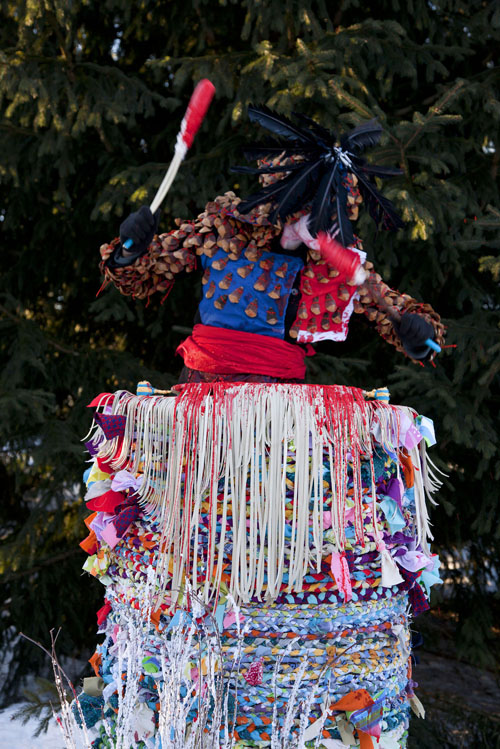 Meryl McMaster, Brumal Tattoo, 2013. From In-Between Worlds series. Digital Chromogenic Print, 36″ x 50″. Courtesy of the artist
Meryl McMaster, Brumal Tattoo, 2013. From In-Between Worlds series. Digital Chromogenic Print, 36″ x 50″. Courtesy of the artist
In Brumal Tattoo, I constructed a sculptural, armour-like garment of pinecones. The large drum that extends from my body references music in European military use and Aboriginal symbolism at the same time. Historically, Europeans used “field music” to control troops on the battlefield as well as for entertainment. In Aboriginal culture, the beating of a drum represents the beating heart. I braided many different patterned fabrics to show the merging of my ancestry. ‘Brumal’ means wintery and ‘Tattoo’ means either a signal sounded on a drum to summon soldiers or a permanent mark or design on the skin. The drumming represents my beating heart and my soul. You can see the sound and vibrations all around me in the red paint splattered on the landscape and on my body. The sound leaves its patterns; it is a tattoo of my past, present and future.
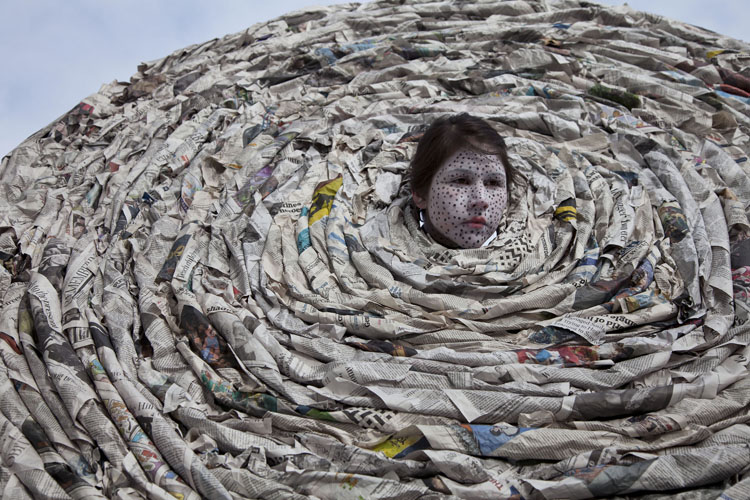 Meryl McMaster, Aphoristic Currents, 2013. From In-Between Worlds series. Digital Chromogenic Print, 36″ x 50″. Courtesy of the artist
Meryl McMaster, Aphoristic Currents, 2013. From In-Between Worlds series. Digital Chromogenic Print, 36″ x 50″. Courtesy of the artist
In Aphoristic Currents the large, exaggerated Victorian ruff, made of carefully selected newsprint, represents language, technology, communication, information, and power in the past and present. The ruff also appears as flowing water or wind and my face is
camouflaged in the likeness of the newspaper.
E.K-H: This series seems to focus on native culture and artistry. Nature plays a major rule in the setting of most these photographs. Even the “bloodiest” one, Victoria, is cool. There is a distance in them, like silence and solitude.
M.M: A pivotal inspiration that has continued to influence and feed my creative mind has been my experiences over the past several years exploring and working in remote natural landscapes in Canada. As part of these trips everyone in the group gets to learn to survive by going through a solo experience in which you are left by yourself with only a little food and shelter supplies for 3 days. Being a young person, you are not only bored out of your mind as you are not allowed to bring anything with you (e.g. a book or music) but you are also at times scared as your imagination is running wild with all the noises from the forest, especially when night falls. Once I became comfortable with my surroundings, I began to think about life back home, how this experience would change me and what my future would look like. Following the struggle of seclusion, I began to feel a sense of empowerment. It was these moments of being both in the group, as well as alone, in such a harsh foreign environment that profoundly affected me and changed how I see the world. These adventures and challenges were an important catalyst in the process of developing my personal identity. Reflecting on my solo experience, I found many similarities to the ancient practice found in several Aboriginal cultures, of the vision quest in which a youth goes out alone into the wilderness, and, through a combination isolation and fasting, tries to find themself and their life direction. Several years later I felt as though I could continue this process of self-discovery through my art practice by exploring various new themes, namely identity, history, the unconscious, perception, myth and the environment. The photographs in “In-Between Worlds” are a further embodiment of this transformation. I chose to give the images dream-like qualities as I remembered odd and unexplainable situations from my solo experience.
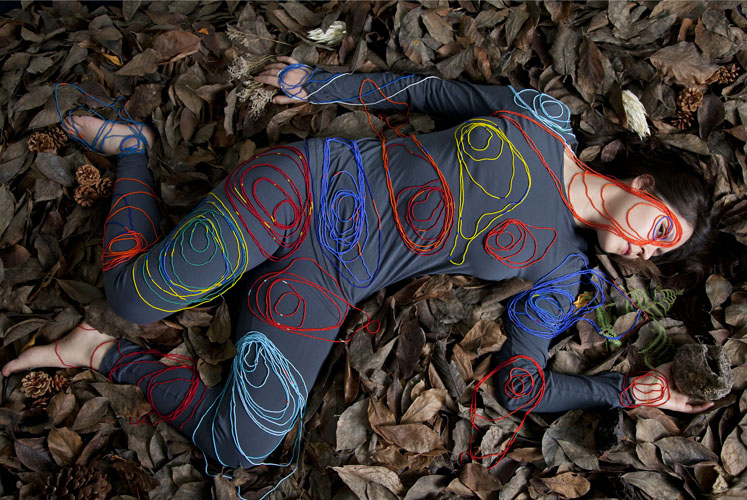 Meryl McMaster, Terra Cognitum, 2013. From In-Between Worlds series. Digital Chromogenic Print, 36″ x 50″. Courtesy of the artist
Meryl McMaster, Terra Cognitum, 2013. From In-Between Worlds series. Digital Chromogenic Print, 36″ x 50″. Courtesy of the artist
In Terra Cognitum, I created a large-scale beadwork pattern. The small colourful seed beads can be found in traditional aboriginal clothes and weaving. Beads were one of many things used as a form of currency for trading during the colonial period. The concentric circle patterns represent a topographic map overlaid on my body and the land around me. This references exploration, colonization and my connection to the land. The map is missing sections. These missing links connect back to my continued exploration and understanding of myself.
E.K-H: All the images were “staged”. How were the works put together?
M.M: My process is layered and time-consuming. While I choose to use photography as my primary medium, I have found it useful to incorporate other artistic media into how I build images and strive for a successful synergy using multiple media. My resulting works take advantage of both the spontaneity of photography and the systematic craft of other media, including sculpture. This synergy allows me to create surreal or augmented imagery that – I hope – allows the viewer to become lost within their own thoughts; transported out of ordinary life.
These images were all photographed in Ottawa in the middle of winter using natural light. Each photo shoot took a couple of hours with an assistant helping me. It took a long time to set up because of the different elements and props in the images. As well, because these are self-portraits there was a lot of going back and forth, from in front of the camera to behind the lens, making sure everything was how I envisioned it.
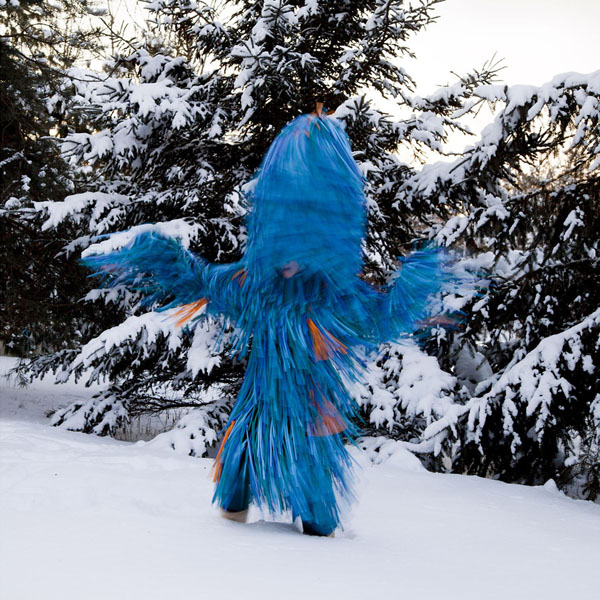 Meryl McMaster, Wind Play, 2012. From In-Between Worlds series. Digital Chromogenic Print, 36″ x 36″. Courtesy of the artist
Meryl McMaster, Wind Play, 2012. From In-Between Worlds series. Digital Chromogenic Print, 36″ x 36″. Courtesy of the artist
E.K-H: You were the model in all of these photographs. Why?
M.M: It was important to me that I be the subject in this work as the core of this series was inspired by my personal experiences. Art is how I express myself and being the subject of my work, I think, brings me closer to the ideas. I’m surfacing in both a positive and negative way as I’m confronted and challenged to find a better understanding of myself. I inserted my own body into visual spaces that reflected both the inspiration I felt from my time alone in nature as well as the concept of being ‘betwixt’.
